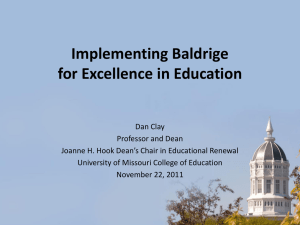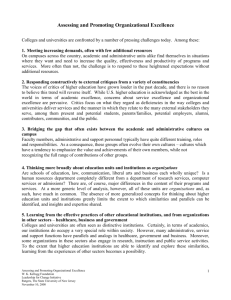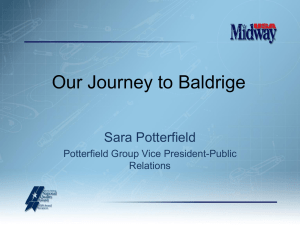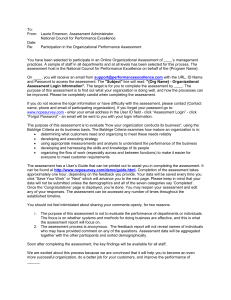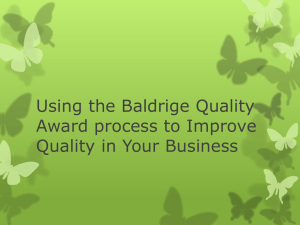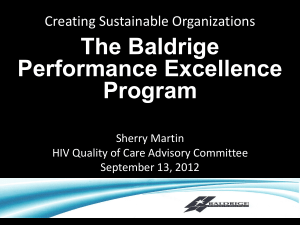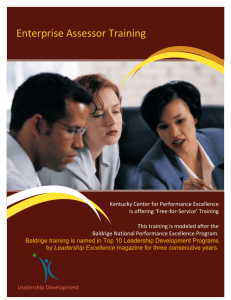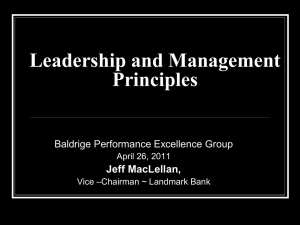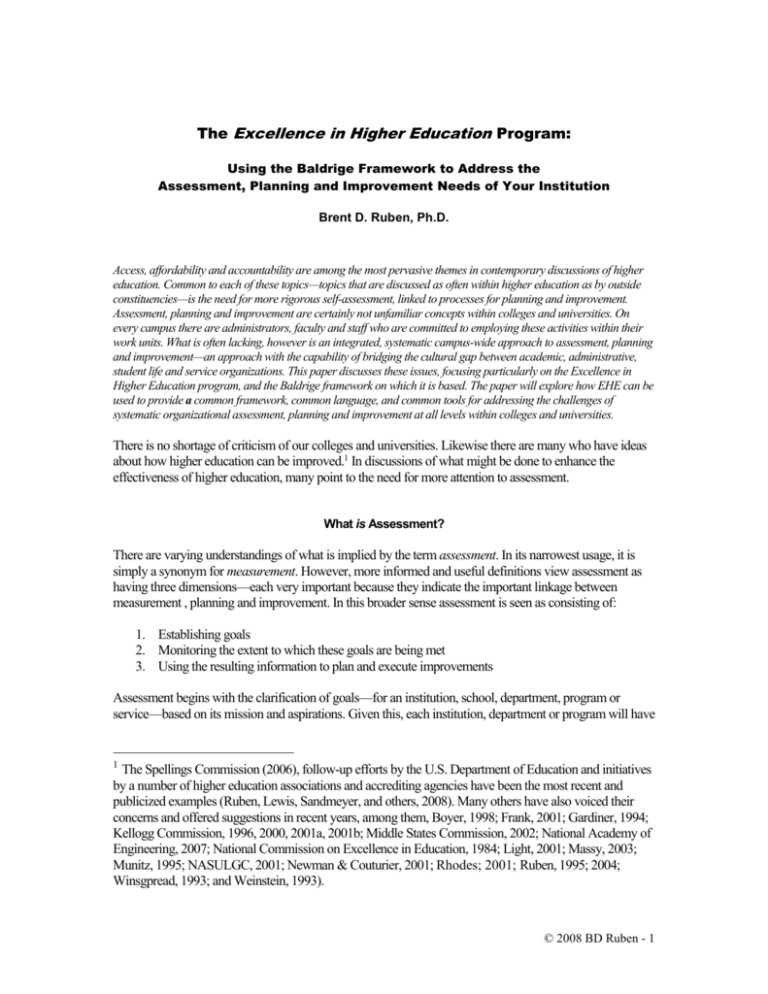
The Excellence in Higher Education Program:
Using the Baldrige Framework to Address the
Assessment, Planning and Improvement Needs of Your Institution
Brent D. Ruben, Ph.D.
Access, affordability and accountability are among the most pervasive themes in contemporary discussions of higher
education. Common to each of these topics—topics that are discussed as often within higher education as by outside
constituencies—is the need for more rigorous self-assessment, linked to processes for planning and improvement.
Assessment, planning and improvement are certainly not unfamiliar concepts within colleges and universities. On
every campus there are administrators, faculty and staff who are committed to employing these activities within their
work units. What is often lacking, however is an integrated, systematic campus-wide approach to assessment, planning
and improvement—an approach with the capability of bridging the cultural gap between academic, administrative,
student life and service organizations. This paper discusses these issues, focusing particularly on the Excellence in
Higher Education program, and the Baldrige framework on which it is based. The paper will explore how EHE can be
used to provide a common framework, common language, and common tools for addressing the challenges of
systematic organizational assessment, planning and improvement at all levels within colleges and universities.
There is no shortage of criticism of our colleges and universities. Likewise there are many who have ideas
about how higher education can be improved.1 In discussions of what might be done to enhance the
effectiveness of higher education, many point to the need for more attention to assessment.
What is Assessment?
There are varying understandings of what is implied by the term assessment. In its narrowest usage, it is
simply a synonym for measurement. However, more informed and useful definitions view assessment as
having three dimensions—each very important because they indicate the important linkage between
measurement , planning and improvement. In this broader sense assessment is seen as consisting of:
1. Establishing goals
2. Monitoring the extent to which these goals are being met
3. Using the resulting information to plan and execute improvements
Assessment begins with the clarification of goals—for an institution, school, department, program or
service—based on its mission and aspirations. Given this, each institution, department or program will have
1
The Spellings Commission (2006), follow-up efforts by the U.S. Department of Education and initiatives
by a number of higher education associations and accrediting agencies have been the most recent and
publicized examples (Ruben, Lewis, Sandmeyer, and others, 2008). Many others have also voiced their
concerns and offered suggestions in recent years, among them, Boyer, 1998; Frank, 2001; Gardiner, 1994;
Kellogg Commission, 1996, 2000, 2001a, 2001b; Middle States Commission, 2002; National Academy of
Engineering, 2007; National Commission on Excellence in Education, 1984; Light, 2001; Massy, 2003;
Munitz, 1995; NASULGC, 2001; Newman & Couturier, 2001; Rhodes; 2001; Ruben, 1995; 2004;
Winsgpread, 1993; and Weinstein, 1993).
© 2008 BD Ruben - 1
goals which will be unique, to some extent at least. These goals will reflect the general as well as distinctive
nature of their purposes, aspirations, and plans.
The second phase in the assessment process is the development of a system of information- and evidencegathering to determine the effectiveness of the institution or department in achieving its goals. In this phase
criteria, indicators, and information-gathering tools are identified or developed, and implemented. This is
the “measurement” component of the assessment process.
Once this information and evidence is collected it can be used in any of a number of ways, and this use
constitutes the third phase of the assessment process. Most fundamentally, the information is to document
successes and to identify gaps in the effectiveness of the unit or institution’s work. This information may be
useful to institutional, departmental or programmatic reviews; for the accrediting process; or for updating
other external constituencies or stakeholder groups. Over time, the information can also be useful to guide a
review and refinement of the goals and more fundamental directions of the organization, and for educating
internal and external publics about achievements, accomplishments and progress—for telling the
institution’s, program’s, or department’s story.
For the value of assessment to be fully realized, however, the information and evidence is used to motivate
and guide planning and improvement—a process some have referred to as a “closing of the loop.” It is in
providing the critical linkage between these various steps that the Excellence in Higher Education
framework, and the Malcolm Baldrige model on which it is based is particularly valuable.
The Baldrige Framework
Of the various approaches for integrating organizational assessment, planning and improvement,
none has been more successful or more influential than the Malcolm Baldrige model (Baldrige,
2008a). Named after Secretary of Commerce Malcolm Baldrige, who served from 1981 until his
death in 1987, the Malcolm Baldrige National Quality Award Program (MBNQA) was
established by the United States Congress in 1987. Since its inception, the intent of the program
has been to promote U.S. business effectiveness for the advancement of the national economy. To
do this, the Baldrige program provides a systems framework for organizational assessment and
improvement, that:
Identifies the essential components of organizational excellence
Recognizes organizations that demonstrate these characteristics
Promotes information sharing by exemplary organizations
Encourages the adoption of effective organizational principles and practices
The program, which is administered by the National Institute for Standards and Technology
(NIST), has also been important in national and international efforts to identify and encourage the
application of core principles of organizational excellence.
The broadly stated purpose of the accreditation process is to “stimulate … evaluation and
improvement, while providing a means of continuing accountability to constituents and the
public” (Southern Association 2001, 3), much the same can be said of the Malcolm Baldrige
framework. As with accreditation frameworks, the Baldrige approach emphasizes the need to
broadly define excellence; value leadership and planning; establish clear, shared, and measurable
goals; create effective programs and departments; conduct systematic assessments of outcomes;
© 2008 BD Ruben - 2
and engage in comparisons with peers and leaders.2 The two frameworks also share in common
the position that review, planning, and continuous improvement are fundamental to institutional
effectiveness and should be thoroughly integrated into the fabric of every institution aspiring to
excellence (Baldrige, 2006a; Middle States Commission, 2002; North Central Association, 2004,
Western Association of Schools and Colleges, 2008). The most fundamental characteristic of the
perspectives is a commitment to an iterative process of mission-based goal setting, assessment,
and improvement. By emphasizing the importance of clear purposes and aspirations, the
evaluation of departmental and institutional effectiveness, and the use of this information for
continuous improvement, the model integrates the core values of accreditation into the day-to-day
activities of the institution. While the Baldrige framework and process is not a substitute for
accreditation, it is compatible with and reinforces accreditation values and standards, and as will
be described later, the EHE model can be used to contribute directly to preparation for
accreditation and other formal review processes.
Baldrige Categories
The Baldrige framework covers seven categories. Although the language and definitions used to
describe the framework have changed over the years, and vary somewhat from sector to sector,
the seven basic themes are constant. In general terms, the framework suggests that organizational
excellence requires:
1. Effective leadership that provides guidance and ensures a clear and shared sense of
organizational mission and future vision, a commitment to continuous review and
improvement of leadership practice, and social and environmental consciousness.
2. An inclusive planning process and coherent plans that translate the organization’s
mission, vision, and values into clear, aggressive, and measurable goals that are
understood and effectively implemented throughout the organization.
3. Knowledge of the needs, expectations, and satisfaction/dissatisfaction levels of the
groups served by the organization; operating practices that are responsive to these needs
and expectations; and assessment processes in place to stay current with and anticipate
the thinking of these groups.
4. Development and use of indicators of organizational performance that capture the
organization’s mission, vision, values, goals, and provide data-based comparisons with
peer and leading organizations; widely sharing this and other information within the
organization to focus and motivate improvement.
5. A workplace culture that encourages, recognizes, and rewards excellence, employee
satisfaction, engagement, professional development, commitment, and pride; and
synchronizes individual and organizational goals.
6. Focus on mission-critical and support programs and services, and associated work
processes to ensure effectiveness, efficiency, appropriate standardization and
documentation, and regular evaluation and improvement — with the needs and
expectations of beneficiaries and stakeholders in mind.
2
For a comparative analysis of educational goals and outcomes identified by the regional and professional accrediting
associations, see Association of American Colleges and Universities (2004, 20–21).
© 2008 BD Ruben - 3
7. Documented, sustained positive outcomes relative to organizational mission, vision,
goals, the perspectives of groups served, and employees, considered in light of
comparisons with the accomplishments of peers, competitors, and leaders. (Ruben, 2004)
The Baldrige model has been an extremely popular framework for organizational self-assessment
in many settings. In addition to the more than 1000 organizations that have applied for Baldrige
review and recognition (Baldrige, 2008c), NIST estimates that thousands of organizations have
used the criteria for self-assessment. It is also evidence that, from a financial perspective,
MBNQA winning organizations outperform other organizations. Przasnyski and Tai’s (2002)
analysis demonstrates that organizations that have been recognized as leaders by Baldrige
perform well in the marketplace and, specifically, that “companies derive the most benefit,
through evaluating and responding to the [Baldrige] guidelines” (p. 486). And, there is evidence
that these organizations excel in both growth and profits. Further evidence suggests that the
Baldrige provides a valuable gauge of organizational effectiveness. A study by the Government
Accounting Office of 20 companies that scored high in the Baldrige process found these results
corresponded with increased job satisfaction, improved attendance, reduced turnover, improved
quality, reduced cost, increased reliability, increased on-time delivery, fewer errors, reduced lead
time (customers), improved satisfaction, fewer complaints, higher customer retention rates
(profitability), improved market share, and improved financial indicators (Heaphy & Gruska,
1995.) In sum, there is a good deal of evidence to suggest that organizations scoring well on
Baldrige standards are more successful than others, providing support for assertions that the
Baldrige criteria provide a standard of excellence to which organizations can and should aspire.
Baldrige in Higher Education
The Baldrige framework has been adopted, adapted and used for assessment in any number of
settings in business, and in 1999, the National Baldrige program advanced versions of the
framework for healthcare and education. The education criteria (Baldrige, 2008b) were intended
to be broadly applicable to school and educational settings—public, private or corporate—at all
levels. Since its introduction, a total of 142 applications have been submitted from higher
education departments or institutions to the national program.3 Three applicants have been
selected as winners of the award—the University of Wisconsin-Stout in 2001, the University of
Northern Colorado, School of Business in 2004, and Richland College in 2005. There have been a
number of college and university applications to state programs that parallel the Baldrige, and
several winners including the University of Missouri-Rolla in 1995 and Iowa State University in
2004.
Beyond higher education institutions’ direct participation in the formal national and state awards
program, the influence of the framework in higher education has been most apparent in the
evolution of accrediting standards of professional and technical education, and more recently in
regional accreditation. In business, engineering, healthcare and education, the standards for
accreditation of college and university programs have come to mirror the Baldrige framework in
many respects. The regional accrediting associations, perhaps most notably the North Central
Association of Schools and Colleges, the Middle States Association of Schools and Colleges,
Western Association of Schools and Colleges, and the Southern Association of Schools and
3
This number, provided by the Baldrige National Quality Office in February, 2006 includes some
repetitive submissions.
© 2008 BD Ruben - 4
Colleges emphasize issues that are central to the Baldrige framework such as leadership, strategic
planning, assessment and continuous improvement.4
The Excellence in Higher Education Framework
The Excellence in Higher Education (EHE) model was developed at Rutgers University as an
adaptation of the Baldrige designed specifically for use within colleges and universities.5 The
2007 version (Ruben, 2007a; 2007b; 2007c) is the seventh revision of the framework. EHE was
designed specifically for higher education institutions, where the mission typically includes an
emphasis on teaching/learning, scholarship/research and public service/outreach. Additionally,
the EHE model was designed to be applicable for use in assessment and planning activities not
only by entire institutions, but also by individual units of all kinds within colleges and
universities—business, student services and administration, as well as academic.
The latest version Excellence in Higher Education was developed to provide an integrated
approach to assessment, planning, and improvement, drawing on the framework of the Malcolm
Baldrige Program of the National Institute of Standards and Technology as well as on standards
and language developed by U.S. college and university accrediting associations.6 Together the
Baldrige criteria and those developed by the regional accreditation organizations offer the best
available standards of excellence for higher education, and it is the goal of this EHE is to provide
a synthesis of the perspectives and language of those robust frameworks.
The EHE Categories
The EHE framework consists of 7 categories or themes that are viewed as relevant to the
effectiveness of any educational enterprise—program, department, school, college or university.
The categories are seen as components of an interrelated system, as shown in Figure 1, and
described below:
Category 1—Leadership. Category 1 considers leadership approaches and governance systems
used to guide the institution, department, or program; how leaders and leadership practices
encourage excellence, innovation, and attention to the needs of individuals, groups, and/or
organizations that benefit from the programs and services of the institution, department, or
program; and how leadership practices are reviewed and improved.
4
See the Middle States Association of Schools and Colleges (www.msache.org), the New England Association of
Schools and Colleges (www.neasc.org/cihe.htm), the North Central Association of Schools and Colleges
(www.ncahigherlearningcommission.org), the Northwest Association of Schools and Colleges (www.nwccu.org), the
Southern Association of Schools and Colleges (www.sacscoc.org), and the Western Association of Schools and
Colleges (www.wascweb.org). With a foundation of Baldrige concepts, the NCA has created an alternative to the
accreditation model called the Academic Quality Improvement Program in which some 200 are presently participating
(AQIP, 2005; AQIP, 2005b)
5
The first version of this model was called Tradition of Excellence and was published in 1994 (Ruben, 1994). Revised
and updated versions were published under the current name, Excellence in Higher Education in 1994 (Ruben, 1994);
1997 (Ruben & Lehr, 1997a, 1997b), 2000 (Ruben, 2000a, 2000b, 2000c) 2001 (2001a, 2001b, 2001c), 2003 (2003a,
2003b, 2003c), and 2005 (Ruben, 2005a, 2005b, 2005c).
6
See listings in Note 4.
© 2008 BD Ruben - 5
Category 2—Plans and Purposes. The strategic planning category considers how the mission,
vision, and values of the institution, school, department, or program are developed and
communicated; how they are translated into goals and plans; and how faculty and staff are
engaged in those activities. Also considered are the ways in which goals and plans are translated
into action and coordinated throughout the organization.
Category 3 —Beneficiaries and Constituencies. The beneficiaries and constituencies category
focuses on the groups that benefit from the programs and services offered by the program,
department, or institution being reviewed. The category asks how the organization learns about
the needs, perceptions, and priorities of those groups, and how that information is used to enhance
the organization’s reputation and working relationships with those constituencies.
Category 4 —Programs and Services. Category 4 focuses on the programs and services offered
by the institution, department, or program under review and how their effectiveness is maintained
and enhanced. The most important operational and support services are also reviewed.
Category 5—Faculty/Staff and Workplace. Category 5 considers how the program, department,
or institution being reviewed recruits and retains faculty and staff, encourages excellence and
engagement, creates and maintains a positive workplace culture and climate, and promotes and
facilitates personal and professional development.
Excellence in Higher Education:
The Framework and Categories
Dimensions of Institutional Effectiveness…
2.0
PURPOSES &
PLANS
6.0
ASSESSMENT &
INFORMATION USE
1.0
4.0
PROGRAMS &
SERVICES
LEADERSHIP
5.0
FACULTY/STAFF &
WORKPLACE
7.0
OUTCOMES &
ACHIEVEMENTS
3.0
BENEFICIARIES &
CONSTITUENCIES
Copyright 2008 • BD Ruben • All rights reserved • 1
Figure 1
The Excellence in Higher Education Framework
Category 6—Assessment and Information Use. The assessment and information use category
focuses on how the program, department, or institution assesses the effectiveness of its
institutional, teaching/learning, research/scholarship, and/or service/outreach efforts relative to its
mission and aspirations. Also considered is how assessment information is used for improving
© 2008 BD Ruben - 6
programs and services, day-to-day decision making, and the quality of the program, department,
or institution, more generally.
Category 7—Outcomes and Achievements. Reporting outcomes and achievements is the theme of
Category 7. The category asks for information and evidence to document or demonstrate the
quality and effectiveness of the program, department, or institution.
The EHE Process
The most usual context for using the EHE program at Rutgers and elsewhere is a retreat or
workshop. Typically, the workshops last one and a half days. The workshop approach has the
advantage of focusing the group’s with an intensity that is difficult to achieve in other methods.
That model is not viable in some situations and with some groups, and there are many other ways
in which the program can be implemented. For example, it can be presented in three half-day
sessions, or each category can become the focus of a series of one or two-hour sessions.
Each EHE workshop consists of a step-by-step organizational assessment process, moving
through the 7 categories one at a time. For each category, the process includes (Ruben, 2005b):
Discussing the basic themes and standards for the category
“Brainstorming” a list of strengths and areas for improvement for the unit with respect to
the category
Reviewing “best” practices in the category as practiced by leading organizations
Scoring the unit in the category on a 0 to 100% scale to capture perceptions of the extent
to which the unit is fulfilling the standards of the category7
The scoring for each category is conducted anonymously and the ratings are displayed, and the
distribution of scores is discussed. The mean rating for the group is then calculated and entered
on a chart, which is also displayed and discussed after each category, and again at the conclusion
of all categories. See Figure 2 for an example of ratings for a hypothetical department.
Once these steps have been taken for all 7 categories, the list of areas of strength and those in
need of improvement are reviewed and discussed further. Next, multi-voting is employed to rankorder the priority areas for improvement in terms of importance, potential impact and feasibility.
Improvement goals and strategies are then established for the highest priority areas—generally
the 4-6 areas perceived to be most pressing and important. Finally, participants in break-out
groups develop preliminary plans for addressing each of the priority areas for improvement. The
preliminary plan includes: a sentence summary of what needs to be done, a list of key steps,
identification of the individuals or roles that should be involved in the project, a proposed team
leader, a project time-line, estimate of resources, and identification of important outcomes
(Ruben, 2007a, 2007b).
7
In some instances, due to time restrictions or participant resistance to the idea of quantitative scoring of this type, the
scoring component of the process has been omitted. While eliminating the scoring from the precision of the rating
process, and the possibility of clarifying the extent of similarity/difference in perceptions among participants, it does
not seem to materially alter the process or its value in other ways.
© 2008 BD Ruben - 7
Sample Profile
1
2
Leadership
Purposes
& Plans
3
4
Beneficiaries & Programs &
Services
Constituencies
5
6
Faculty/Staff Assessment &
& Workplace Information Use
7
Outcomes &
Achievements
Most
80
Many
60
Few Some
90
40
None
All
100%
10
70
50
30
20
48%
38%
35%
23%
33%
32%
19%
0%
Copyright 2008 • BD Ruben • All rights reserved • 3
Figure 2
A Sample Rating Profile
The formal workshop ends at this point, and it becomes the responsibility of the program,
department, or institution to move forward on the improvement initiatives, periodically reporting
progress back to colleagues. As the selected priority projects are completed, the group could
return to the list of other areas for improvement to select the next round of improvements. It is
recommended that the process—illustrated in Figure 3—be undertaken on an annual or semiannual basis.
In some instances and with some groups—senior administrators, for example—it may be
desirable or necessary to present a condensed overview of the model and process. While it is not
possible to go through the entire process in a half day, it is possible to provide an overview of the
categories and to provide an explanation of how the process works.
At Rutgers and a number of other higher education institutions8, the EHE model has been used as
an organizational self-assessment program within academic, student life, administrative and
service departments with the aim of deriving the benefits described above.
8
Higher education departments and institutions completing the Baldrige/EHE program include
business/service/administrative departments and academic units at Rutgers University; University of California,
Berkeley; University of Wisconsin, Madison; Penn State University; University of Pennsylvania; University of San
Diego; California State University, Fullerton; Miami University; Raritan Valley Community College; Howard
University; University at Buffalo; University of Illinois; Excelsior College; Marygrove College; Azusa Pacific
University; University at Binghamton; University of Vermont; University of Massachusetts; MIT; University of
Cincinnati; University of Texas, Austin; Seton Hall University; Texas A & M University, University of Charleston,
California State University and several campuses, and others.
© 2008 BD Ruben - 8
The EHE Process
1
5
Complete Projects and
Report Progress
Assess
2
4
Prioritize Areas for
Improvement
3
Implement
Projects
Plan
PlanImprovement
Improvement
Projects
Projects
Copyright 2008 • BD Ruben • All rights reserved • 2
Figure 3
The EHE Process
The applicability of a single organizational framework for reviewing and improving departments
and programs that are academic as well as administrative, is a unique and important attribute of
the EHE approach. Within academic units, the process naturally focuses on how the college or
department may function more effectively to fulfill its academic mission and aspirations, to
evaluate its accomplishments and improvement needs, to address student learning and service
needs, to identify departmental processes that can be streamlined, to address faculty and staff
needs, to build its reputation on campus and beyond, and how, in general, to function more
effectively as a department or school for the good of all. Within service units, the natural focus is
on mission and aspirations, the core programs and services the unit provides, and ways to assess
and improve the effectiveness and efficiency, how to use technology to streamline work
processes, how to enhance service relations with external constituencies, and so on. Using the
same model within academic, student life, administrative and service units creates a common,
institution-wide vocabulary for assessing, planning and improving organizational effectiveness. It
also fosters the sharing of approaches and strategies across units, and it promotes the sense that
each part of the system is an important and interdependent part of the campus system as a whole.
To date, 45 academic and administrative departments at Rutgers have participated in the program. Roughly
35 other colleges and universities have found this program helpful in their assessment and improvement
efforts, among them: the University of California at Berkeley; Penn State University, University of
Wisconsin, Madison; Texas A & M University, the State University of New York at Buffalo; MIT; and
California State University. Like the Baldrige framework, on which it is based, the EHE model covers 7
© 2008 BD Ruben - 9
categories deemed important to organizational effectiveness.9 Although the language and definitions used
to describe the framework have changed somewhat over the years, and vary somewhat from sector to
sector, the seven basic themes are constant.
The Value and Impact of the EHE Program
With any assessment program—accreditation, Baldrige or EHE process—there is always the
question of whether the initiative has the intended value and impact. Within higher education
environment, good intentions and enthusiasm for a program’s effectiveness are not persuasive.
Administrators, staff, and particularly faculty want evidence.
To this end, two studies have been undertaken. The first study (Ruben, Connaughton, Immordino &
Lopez, 2004) consisted of a web-based survey of participants’ perceptions of the EHE assessment
process several months after completion of the workshops. The participating departments in this
study were broadly representative of the university. There were three
business/service/administrative departments10, and three units whose missions are primarily
academic. The goal of this study was to evaluate learning, specifically participants’ perceptions
of the value and knowledge derived from workshop participation. The second study involved inperson interviews with department leaders approximately one year after the workshops. The
second study (Ruben, Russ, Smulowitz, Connaughton, 2007) focused on organizational change
by documenting improvements that have taken place following up on goals established during the
earlier assessment workshop.
Findings from the first study indicated that participants do perceive that the EHE organizational
self-assessment process results in the acquisition of a knowledge and theory base; and leads to the
identification of strengths and improvement needs. Participants reported that as a result of the
workshop, they have increased knowledge and awareness of the Baldrige/EHE criteria, and better
understanding of the importance of the EHE categories for organizational effectiveness. Our findings also
indicate that participants believe the EHE self-assessment workshop and process helps them translate
theoretical knowledge into practical improvement strategies and actions.
In discussing the perceived benefits of the Baldrige/EHE program, participants highlighted the
following elements of the EHE program as being the most beneficial: open discussion,
consideration of performance measures, clarifying the value of planning, review of benchmarking
techniques, and providing feedback on leadership effectiveness in addition to reaffirming some of
the perspectives expressed in their responses to previous questions. The majority of respondents
indicated that no changes were needed in the process. Over two-thirds of the respondents
indicated that the program should be repeated every year or every other year.
A second study (Ruben, Russ, Smulowitz, Connaughton, 2007) focused on organizational change,
investigating the question: Did departments make substantial progress on priorities they
established during the Baldrige/EHE program? Overall, the results suggest the answer is “yes.”
Of the priorities established during the Baldrige/EHE self-assessment process, 65% of them were
executed by the departments, producing “some/considerable progress.” Progress ratings reported
9
In the language of higher education, the categories are: Leadership, Strategic Planning, Beneficiaries and
Constituencies, Measurement and Knowledge Utilization, Programs and Services, Faculty/Staff and Workplace Focus,
and Outcomes and Achievements (Ruben, 2008a).
10
Business/service/administrative departments provide support and programming to external University
constituents, and various operational and maintenance support services to the campus community.
© 2008 BD Ruben - 10
by leaders were substantiated by “improvement steps” that were found to be reflective of a
priority’s perceived importance.
100%
90%
70%
67%
80%
70%
60%
50%
40%
Knowledge
Acquisition
Organizational
Change
30%
20%
10%
0%
Percentage of respondents reporting positive/high
positive learning outcomes from EHE assessment
process
Percentage of priorities with some/considerable progress
Figure 4
Knowledge & Progress Outcomes
(All Departments)
One of the most interesting and fundamental questions raised by these studies has to do with the
relationship between learning resulting from the Baldrige/EHE assessment and subsequent
progress on organizational change priorities: Is there a relationship between knowledge gained
from the self-assessment process and subsequent progress—organizational change-- made
relative to a departments’ EHE improvement priorities? Findings from this study would seem,
intuitively, to support the view that such a relationship does exist, but the design of the studies did
not provide the basis for confirming this relationship empirically. That said, overall, responses
from the individual departments reported relative to organizational change suggest that leaders
perceive that such a relationship exists. Moreover, side-by-side comparisons of findings regarding
perceptions of knowledge acquisition in the first study and documented improvements
implemented by the organization in areas identified as priorities in the second study are also
interesting. Figure 4 compares the knowledge acquisition and organizational change outcomes for
departments which have made progress specifically, the side-by-side figures indicates (1) the
percentage of department members who evaluated the knowledge dimensions of EHE as being
“valuable” or “very valuable” to their enhanced understanding and (2) the percentage of priorities
that the leaders of those departments rated as having “some” or “considerable progress.” As
illustrated, the knowledge outcomes (70%) corresponded very closely to the progress on
organizational change (67%).
© 2008 BD Ruben - 11
To the extent that awareness and knowledge are necessary precursors to action, planning and change, these
results are most significant. They suggest that the Baldrige/EHE self-assessment process provides a solid
foundation of knowledge and helps to define a standard of excellence which contributes an important
dimension to the learning process.
Concluding Comments
From our own experience and available evidence it would seem the EHE program can be most
helpful in attaining a variety of organizational assessment, planning and improvement goals,
including:
Fostering organizational self-reflection
Enhancing participant understanding of dimensions of organizational excellence
Team-building
Increasing and enhancing communication
Professional development
Promoting comparisons and benchmarking
Identifying improvement needs
Providing a model of organizational excellence
Performance measurement
The EHE model provides a tool for assessment that offers a number of particular benefits (Ruben,
2007a). This framework:
Applies accepted standards of organizational excellence
Is appropriate for an entire institution and for specific departments, programs, and
advisory or governing groups
Can be adapted to academic, student service, and business units
Highlights strengths and priorities for improvement
Creates baseline measures
Leverages knowledge gained from other sectors
Fosters a culture of review and improvement
Provides a framework for sharing effective practices
Broadens participation in leadership and problem solving
Identifies problems and solutions that can visibly improve day-to-day operations
Complements new and emerging accreditation models
In summary, the combination of the accreditation and Baldrige frameworks results in an approach
that can be extremely useful as a guide to assessment, planning, and improvement throughout a
college or university—in administrative, service, and student life organizations, as well as in
academic departments and programs, or entire institutions. This is an important capability, when
it comes to addressing many of the challenges noted by higher education’s critics.
Although academic, administrative, and student service functions are interdependent components
of a college or university system, these components interact in a variety of subtle ways, and
collectively they provide the basis for the perceptions—and reality—of a college or university.
While distinctions between the various functional units within our institutions may be extremely
© 2008 BD Ruben - 12
meaningful to those of us who work within higher education institutions, they are much less
significant to external groups. For students and external constituencies, what matters is the quality
of the overall learning and living experience. The Excellence in Higher Education model provides
a robust tool for systematically reflecting on and improving the reality and perception of
excellence for faculty, staff, students, and for the many other important constituency and
stakeholder groups whose views of our colleges and universities are of increasing significant to
the future of higher education. Perhaps most importantly, it is a model that equips faculty and
staff with concepts and tools necessary to provide informed, systematic leadership of the
assessment, planning and improvement process.
© 2008 BD Ruben - 13
References
Baldrige National Quality Program. February 2008a. Program Web site on the National Institute
of Standards and Technology Web pages. www.quality.nist.gov.
Baldrige National Quality Program. 2008b. The 2008 Criteria for Performance Excellence in
Education. Washington, D.C.: National Institute of Standards and Technology.
www.quality.nist.gov/Education_Criteria.htm.
Baldrige National Quality Program. 2008c. Malcolm Baldrige National Quality Award
Application Data—1988-2007. http://www.nist.gov/public_affairs/factsheet/nqa_appdata.htm.
Boyer Commission (1998). Reinventing undergraduate education: A blueprint for America’s
research universities. Stony Brook, NY: State University of New York at Stony Brook for the
Carnegie Foundation.
Frank, R. H. (2001). “Higher education: The ultimate winner-take-all market?” In M. E. Devlin
and J. W. Meyerson (eds.), Forum futures: Exploring the future of higher education-2000 papers.
San Francisco: Jossey-Bass, 1-12.
Gardiner, L F. (1994). Redesigning higher education. ASHE-ERIC higher education report 7.
Washington, DC: George Washington University.
Heaphy, M. S., & Gruska, G. F. (1995). The Malcolm Baldrige national quality award: A
yardstick for quality growth. Reading, MA: Addison-Wesley Publishing Company.
Kellogg Commission. (1996). “Taking charge of change: Renewing the promise of state and landgrant universities,” Washington, DC: National Association of State Universities and Land-Grant
Colleges. http://www.nasulgc.org/Kellogg/kellogg.htm.
Kellogg Commission. (2000) Renewing the covenant: Learning, discovery, and engagement in a
new age and different world. Washington, DC: National Association of State Universities and
Land-Grant Colleges, 2000b. http://www.nasulgc.org/Kellogg/kellogg.htm.
Kellogg Commission. (2001a). Returning to our roots. Executive summaries of the reports of the
kellogg commission on the future of state and land-grant universities. Washington, DC: National
Association of State Universities and Land-Grant Colleges.
http://www.nasulgc.org/Kellogg/kellogg.htm
Kellogg Commission. (2001b). “Leadership for Institutional Change Initiative.” The Kellogg
Commission. Jan. 10, 2002. [http://www.leadershiponlinewkkf.org/];
[http://cuinfo.cornell.edu/LINC]; [http://www.fspe.org/linc].
Light, R. J. Making the most of college: Students speak their minds. Cambridge, Harvard
University Press, 2001.
Massy, W. F. (2003). Honoring the trust. Bolton, MA: Anker.
Middle States Commission on Higher Education. (2002). Characteristics of excellence in higher
education: Eligibility requirements and standards for accreditation, Philadelphia: Middle States
Commission on Higher Education.
© 2008 BD Ruben - 14
Munitz, B. (Nov 28, 1995). New leadership for higher education. California State University
Information Bulletin, 52(15). Adapted from B. Munitz (Fall, 1995), Planning for higher
education, Society for College and University Planning, Ann Arbor.
National Academy of Engineering, and Institute of Medicine of the National Academies. (2007). Rising
Above the Gathering Storm. Washington, DC: National Academies Press.
National Commission on Excellence in Education. (1984). A Nation at Risk. Portland Oregon: USA
Research.
National Association of State Universities and Land-Grant Colleges (NASULGC). (2001).
Shaping the future: The economic impact of public universities. Washington, D.C.: National
Association of State Universities and Land-Grant Colleges.
North Central Association of Colleges and Universities. The Higher Learning Commission. July
2004. Higher Learning Commission’s Academic Quality Improvement Project. http://AQIP.org.
Northwest Commission on Colleges and Universities. (2004). Accreditation Standards.
Redmond, WA.
Newman, F., & Couturier, L. K. (Sept./Oct., 2001). “The new competitive arena: Market forces
invade the academy.” Change, 33(5), 10-17.
Przasnyski, Z., & Tai, L. S. (2002). Stock performance of Malcolm Baldrige National Quality
Award Winning companies. Total Quality Management, 13 (4), 475-488.
Rhodes, F. H. (2001). The creation of the future: The role of the American university. Ithaca, NY:
Cornell University Press.
Ruben, B.D. (1994). Tradition of excellence: Higher education quality self-assessment guide.
Dubuque, IA: Kendall-Hunt.
Ruben, B. D. and Lehr, J. (1997a). Excellence in higher education: A guidebook for selfassessment, strategic planning and improvement in higher education. Dubuque, IA: KendallHunt.
Ruben, B. D. and Lehr, J. (1997b). Excellence in higher education: A workbook for selfassessment, strategic planning and improvement in higher education. Dubuque, IA: KendallHunt.
Ruben, B. D., (2000a). Excellence in higher education: A guide to organizational assessment,
planning and improvement. Washington, DC: National Association of College and University
Business Officers.
Ruben, B. D., (2000b). Excellence in higher education: Organizational assessment, planning and
improvement workbook. Washington, DC: National Association of College and University
Business Officers.
Ruben, B. D., (2000c). Excellence in higher education: Organizational assessment, planning and
improvement facilitator’s guide and case study. Washington, DC: National Association of
© 2008 BD Ruben - 15
College and University Business Officers.
Ruben, B. D. (July 13, 2001). “We need excellence beyond the classroom.” The Chronicle of
Higher Education, (47)44, B15-16.
Ruben, B. D., (2001a). Excellence in higher education: A Baldrige-based guide to organizational
assessment, planning and improvement. Washington, DC: National Association of College and
University Business Officers.
Ruben, B. D., (2001b). Excellence in higher education: A Baldrige-based organizational
assessment, planning and improvement workbook. Washington, DC: National Association of
College and University Business Officers.
Ruben, B. D. (2003a). Excellence in higher education: A Baldrige-based guide to organizational
assessment, improvement and leadership. Washington, DC: National Association of College and
University Business Officers.
Ruben, B. D. (2003b). Excellence in higher education: A Baldrige-based guide to organizational
assessment, improvement and leadership. Workbook and scoring guide. Washington, DC: National
Association of College and University Business Officers.
Ruben, B. D. (2003c). Excellence in higher education 2003-2004: Facilitator’s guide.
Washington, D.C.: National Association of College and University Business Officers.
Ruben, B. D. (2004). Pursuing excellence in higher education: Eight fundamental challenges. San
Francisco: Jossey-Bass.
Ruben, B. D. (2005a). Excellence in higher education: An integrated approach to assessment, planning
and improvement for colleges and universities. National Association of College and University Business
Officers.
Ruben, B. D. (2005b). Excellence in higher education: An integrated approach to assessment, planning
and improvement for colleges and universities: Workbook and Scoring Guide. National Association of
College and University Business Officers.
Ruben, B. D. (2005c). Excellence in higher education: An integrated approach to assessment, planning
and improvement for colleges and universities: Facilitator’s Guide. National Association of College and
University Business Officers.
Ruben, B. D. (2007sa. Excellence in higher education guide: An integrated approach to assessment,
planning and improvement for colleges and universities. National Association of College and University
Business Officers.
Ruben, B. D. (2007b). Excellence in higher education: An integrated approach to assessment, planning
and improvement for colleges and universities: Workbook and scoring manual. National Association of
College and University Business Officers.
Ruben, B. D. (2007c). Excellence in higher education: An integrated approach to assessment, planning
and improvement for colleges and universities: Facilitator’s guide. National Association of College and
University Business Officers.
© 2008 BD Ruben - 16
Ruben, B.D. (2005d). “Linking Accreditation Standards and the Malcolm Baldrige Framework: An
Integrated Approach to Continuous Assessment, Planning and Improvement.” Annual Conference of the
Middle States Commission on Higher Education, Baltimore, MD.
Ruben, B. D. 2006. What leaders need to know and do: A leadership competencies scorecard..
Washington, D.C.: National Association of College and University Business Officers.
Ruben, B. D., T. Russ, S. M. Smulowitz, and S. L. Connaughton. Evaluating the Impact of
Organizational Self-Assessment in Higher Education: The Malcolm Baldrige/Excellence in
Higher Education Framework. Leadership and Organizational Development Journal, 28(3),
2007.
Ruben, B. D., Connaughton, S. L., Immordino, K., & Lopez, J. M. (2006).
(2005). What impact does the Baldrige/excellence in higher education self-assessment process
have on institutional effectiveness? A paper presented at the annual conference of the National
Consortium for Continuous Improvement in Higher Education, Baltimore, MD.
Ruben, B. D., Lewis, L., Sandmeyer, L., Russ, T., Smulowitz, S., and Immordino, K.. (2008).
Assessing the impact of the Spellings Commission: The message, the messenger, and the
dynamics of change in higher education. Washington, DC: National Association of College and
University Business Officers.
Southern Association of Colleges and Schools. Commission on Colleges. 2003. Handbook for
Reaffirmation of Accreditation. Decatur, GA.: Commission on Colleges.
www.sacscoc.org/principles.asp.
Western Association of Schools and Colleges. (2008). Handbook of Accreditation.
http://www.wascsenior.org/findit/files/forms/Handbook_of_Accreditation___July_2008.pdf.
Weinstein, L. A. (1993). Moving a Battleship with Your Bare Hands. Madison, WI; Magna.
Wingspread Group on Higher Education. (1993). An American imperative: Higher expectations
for higher education, Racine WI: Johnson Foundation.
© 2008 BD Ruben - 17

